SOLUTION to EXAMPLE 1.3.4
The information refers to three sets: P (those who punch), C (those who curse), and G (those who make obscene gestures). We will organize the data by using a three-circle Venn diagram.
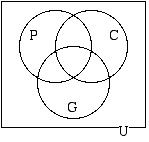
We always we to start by finding the number that goes in the innermost region of the diagram. In this case, we are told that "3 punch and curse and gesture."
This means that in the region where all three circles overlap, we have 3 people:
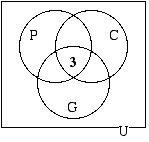
Next, we try to use the other information, whenever possible.
We are told that "10 punch." This means that in the entire circle P we have to place a total of 10 people. Three of the people have already been placed in one region of that circle, but we don't have enough information to be able to distribute the other 7 among the remaining regions of circle P.
For similar reasons, we cannot yet use the information "18 curse"or the information "19 make obscene gestures."
We are told that "12 curse but don't punch and don't gesture." This refers to the part of the diagram that is simultaneously inside of circle C but outside of the other two circles.
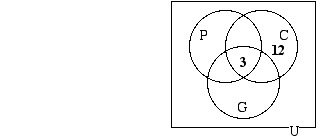
We are also told that "4 curse and gesture." This means that we must account for a total 4 people in the two regions where circle C overlaps circle G. Since we have already placed 3 people in one of the two regions, we have to place 1 person in the second region.
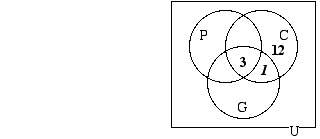
Since "4 punch and gesture but don't curse" we must account for 4 people in the single region that is simultaneously inside of circles P and G but outside of circle C.
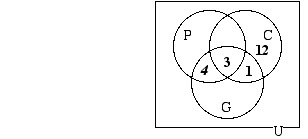
Now that there are numbers in three of the four regions of circle G, we can use the fact that "19 make obscene gestures." We must place the number 11 in the remaining region of circle G so that when we add all four numbers in that circle we have a total of 19.
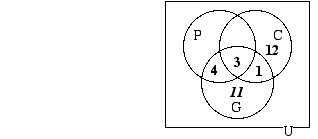
Likewise, since there are numbers in 3 of the four regions of circle C, we can use the fact that "18 curse." We must place the number 2 in the remaining region of circle C in order to obtain a total of 18 in that circle.
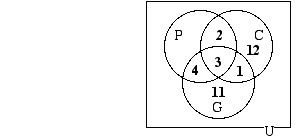
Now we can use the fact that "10 punch." We place the number 1 in the remaining region of circle P in order to get the total of 10 in that circle.
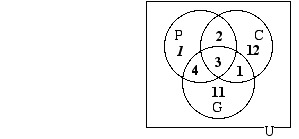
Finally, we use the fact that "5 don't punch, don't curse and don't gesture." This means that we place the number 5 in the region that is outside of all three circles.
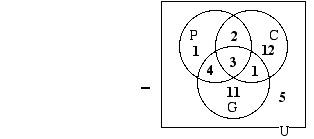
Now that the diagram is filled in in such a way that there is one number in each of its eight regions, we can answer the questions that were given:
1. How many were surveyed?
To answer this, we add all eight numbers: 1 + 2 + 12 + 4 + 3 + 1 + 11 + 5 = 39
2. How many punch and curse?
This refers to the intersection of sets P and C. These two circles overlap in two regions.
The number of people in these two regions combined is 2 + 3 = 5.
3. How many curse or gesture?
This refers to the union of sets C and G. This consists of six regions.
We add the numebrs from all six of these regions: 2 + 12 + 4 + 3 + 1 + 11 = 33.
4. How many engage in exactly one of these activities
There are three regions of the diagram that satisfy this condition:
1 person punches but doesn't curse or gesture;
12 people curse but don't punch or gesture;
11 people gesture but don't punch or curse.
So, the number of people who engage in exactly one of these activities is 1 + 12 + 11 = 24